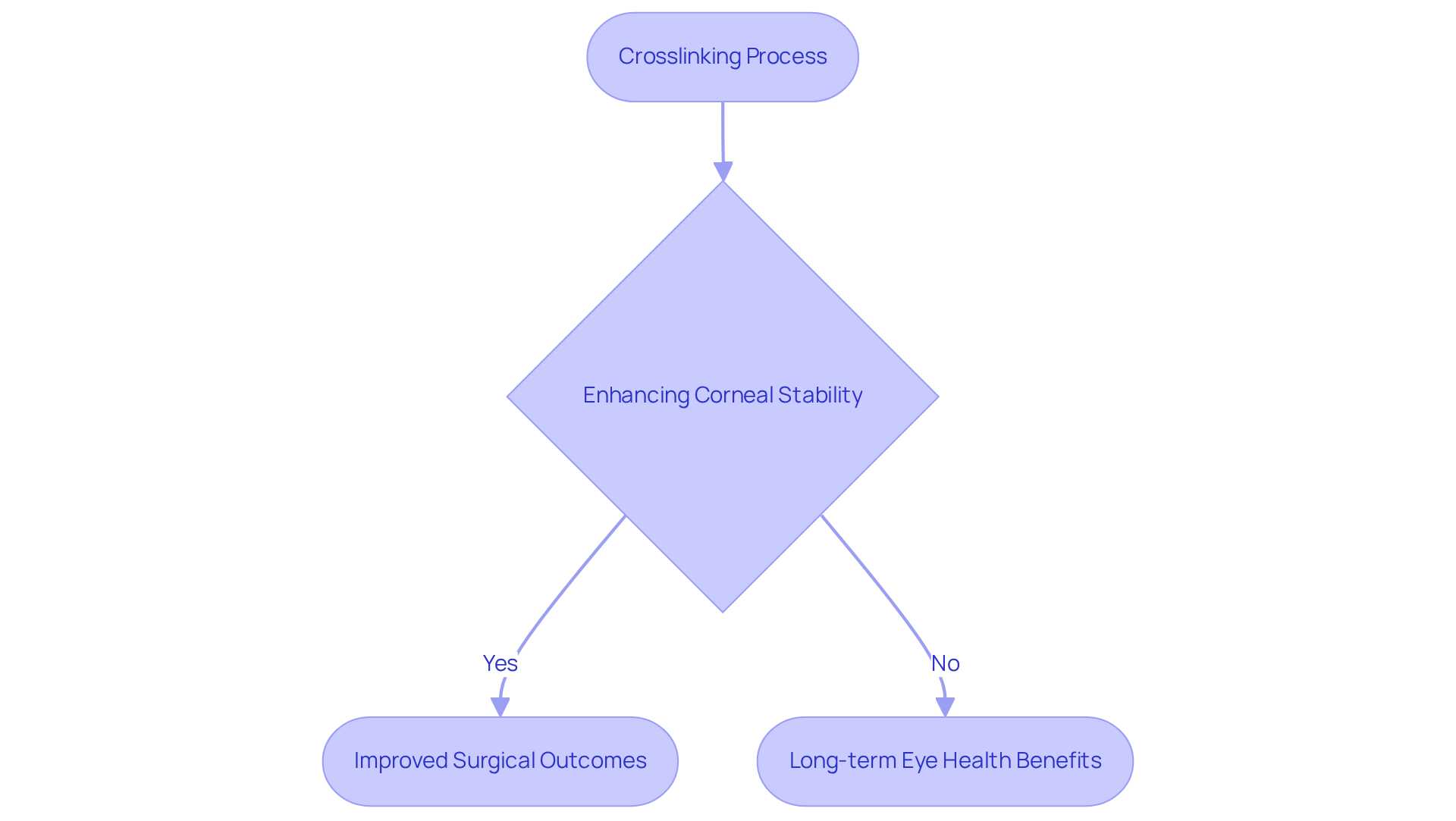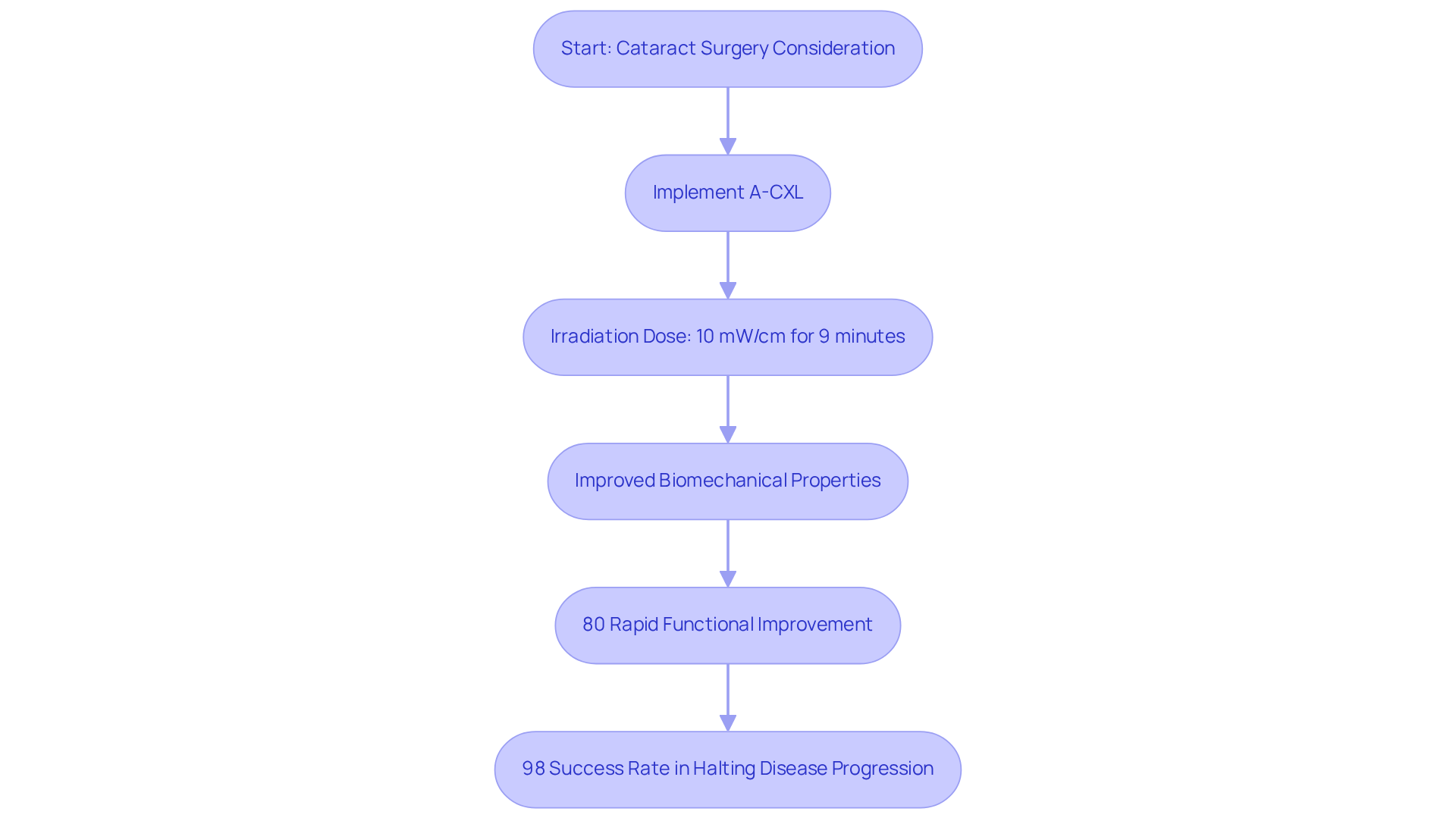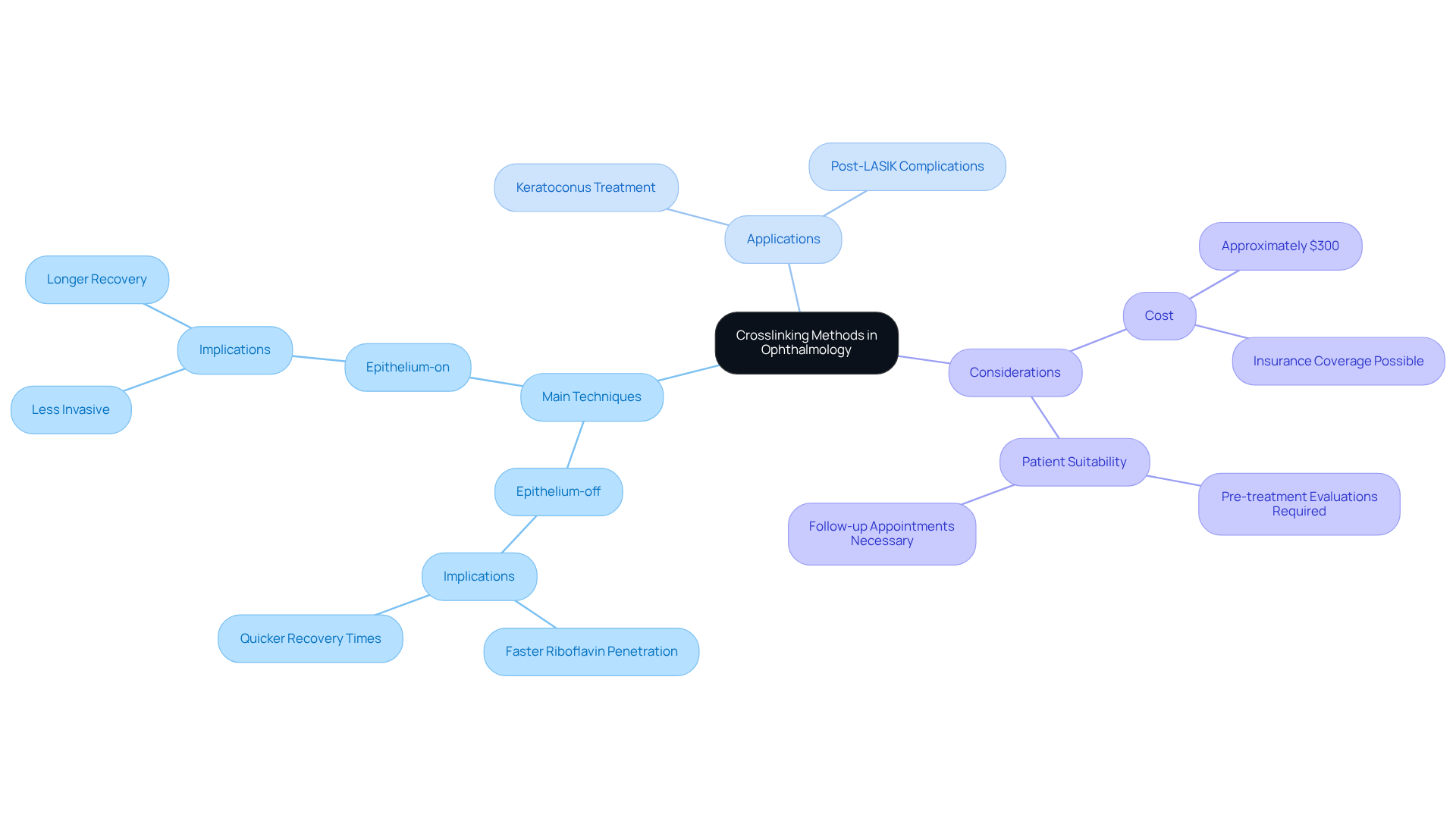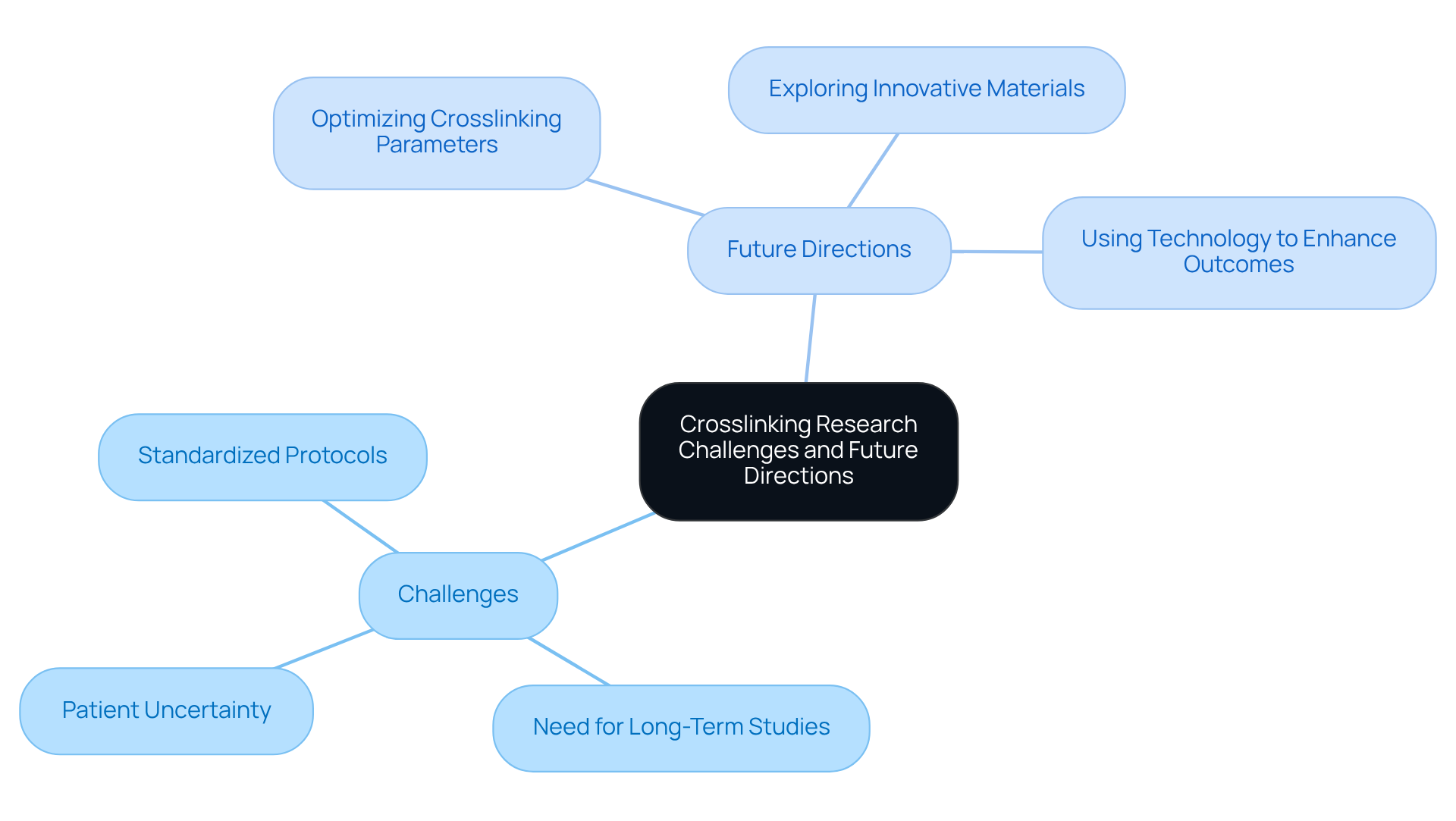Posted by: Northwest Eye in Cataracts, Vision Correction on October 22, 2025
Overview
Crosslinking is a crucial process for cataract patients, as it enhances corneal stability. This improvement leads to better surgical outcomes and fewer postoperative complications. We understand that facing cataract surgery can be daunting, but techniques like accelerated corneal crosslinking (A-CXL) significantly enhance visual acuity and provide reassurance. Research supports this, showing high success rates and rapid functional improvements after the procedure.
It’s common to feel anxious about the unknown, but rest assured that these advancements in treatment are designed with your well-being in mind. Many patients have shared their positive experiences, highlighting how A-CXL has transformed their vision and confidence. We are here to help you through this process, ensuring you feel supported every step of the way.
Introduction
We understand that navigating the complexities of cataract treatment can feel overwhelming for many patients. The innovative technique of crosslinking represents a significant advancement in ophthalmology, enhancing surgical outcomes and providing greater reassurance for those facing lens surgery.
However, with a multitude of treatment options available, it’s common to have questions about the effectiveness and safety of these methods. How can you, as a patient, navigate this evolving landscape to ensure you make informed decisions about your eye health?
We are here to help you through this process.
Define Crosslinking: Understanding the Basics
The process of crosslinking forms chemical bonds between polymer chains, significantly enhancing the structural integrity of tissues. We understand that for individuals facing lens surgery, this method is especially significant. It enhances corneal stability, which can positively influence the outcomes of various surgical procedures.
For those dealing with lens opacity, comprehending the process is vital. It highlights the progress in surgical methods aimed at improving vision and overall eye well-being. Crosslinking can help ensure more predictable and successful surgical results by improving corneal stability. This ultimately benefits patients’ long-term eye health, providing reassurance in a journey that can feel daunting.
We are here to help you through this process, ensuring you feel supported every step of the way.

Explore the Importance of Crosslinking in Various Applications
In ophthalmology, crosslinking plays a crucial role, particularly in enhancing the outcomes of cataract surgeries. We understand that considering surgery can be daunting, but this method significantly improves the biomechanical properties of the cornea, leading to better visual acuity and a reduced risk of postoperative complications. Research shows that accelerated corneal crosslinking (A-CXL) can stabilize the cornea, which is especially important for those with conditions like keratoconus, where preserving corneal integrity is vital.
For individuals facing lens opacity, incorporating linking methods can provide reassurance about the safety and efficacy of their surgical choices. The implementation of A-CXL has demonstrated remarkable enhancements in visual results, with reports indicating that 80% of individuals experience rapid functional improvement after the procedure. It’s common to feel uncertain about the success of such treatments, but specialist opinions emphasize the importance of crosslinking in improving the overall success of cataract procedures. This makes A-CXL a significant factor for both patients and eye care professionals in the field of crosslinking.
Notably, A-CXL involves an irradiation dose of 10 mW/cm for 9 minutes, which has been shown to offer a better therapeutic and safety profile than higher doses for shorter durations. Additionally, the success rate of this procedure in halting the progression of ectatic disease is reported to be an impressive 98% in suitable candidates. This reinforces its effectiveness as a treatment option, and we are here to help you navigate this process with confidence.

Examine Crosslinking Methods: Techniques and Processes
In ophthalmology, we understand that navigating treatment options can be overwhelming. Different linking techniques, including crosslinking, are employed, each tailored to specific applications and patient needs. The primary method involves applying riboflavin (Vitamin B2) to the cornea, followed by exposure to ultraviolet (UV) light. This combination triggers a photochemical reaction that enhances the corneal structure by promoting collagen crosslinking. Patients typically notice results within one week, with most effects experienced within one month.
It’s common to feel uncertain about treatment methods. Alternative methods may employ various photosensitizers or modify UV exposure times to improve results. It’s important to note that there are two main techniques for corneal strengthening:
- Epithelium-off
- Epithelium-on
Each technique has its implications for recovery and effectiveness. Pre-treatment evaluations are essential for determining individual suitability for the procedure.
Grasping these methodologies is vital for individuals with cataracts, as it emphasizes the complex processes of crosslinking that support their surgical treatment and the possible advantages of linking in maintaining vision. As Dr. Emil Chynn notes, ‘Crosslinking (CXL) as a treatment for keratoconus is a promising procedure that results in very positive outcomes with minimal risks involved.’
We also recognize that cost is a concern. The expense of CXL therapy is around $300, and it might be included in insurance coverage, rendering it a feasible choice for numerous individuals. We are here to help you through this process, ensuring you feel supported and informed every step of the way.

Analyze Challenges and Future Directions in Crosslinking Research
While advancements in linking techniques have made significant strides, we understand that challenges still exist. Many of you may be concerned about the establishment of standardized protocols and the need for long-term studies to evaluate the efficacy and safety of these methods. It’s common to feel uncertain about what these developments mean for your eye care.
Looking ahead, future studies are anticipated to focus on:
- Optimizing crosslinking parameters
- Exploring innovative materials
- Using technology to enhance crosslinking outcomes for individuals
For those of you with cataracts, being aware of these developments is crucial, as they signal the potential for more effective treatments on the horizon.
This underscores the importance of continuous education and active engagement with your eye care providers. We are here to help you through this process, ensuring that you are well-informed about your options and the evolving landscape of eye care. Remember, you are not alone in this journey, and there is support available as you navigate your treatment options.

Conclusion
Understanding crosslinking is essential for cataract patients, as it represents a significant advancement in enhancing surgical outcomes and ensuring long-term eye health. We understand that facing lens surgery can be daunting, but this process not only strengthens the cornea but also instills confidence in patients, emphasizing the importance of informed decision-making in their treatment journey.
The article elaborates on the key benefits of crosslinking, particularly in relation to cataract surgery. By improving corneal stability and reducing postoperative complications, techniques like accelerated corneal crosslinking (A-CXL) have demonstrated impressive success rates in enhancing visual acuity. The insights provided highlight the various methodologies and their implications, reassuring patients about the safety and efficacy of their surgical options.
As research continues to evolve, it’s common to feel uncertain about advancements in crosslinking techniques and their potential impact on eye health. Engaging with eye care professionals and understanding the ongoing developments in this field can empower patients to make educated choices regarding their treatment. The journey through cataract surgery can be daunting, but with the right knowledge and support, individuals can navigate this path with confidence and optimism for improved vision and well-being.
Frequently Asked Questions
What is crosslinking?
Crosslinking is a process that forms chemical bonds between polymer chains, which enhances the structural integrity of tissues.
Why is crosslinking significant for individuals facing lens surgery?
Crosslinking is significant for lens surgery as it enhances corneal stability, which can positively influence the outcomes of various surgical procedures.
How does crosslinking benefit those dealing with lens opacity?
For individuals with lens opacity, understanding crosslinking is vital as it represents advancements in surgical methods aimed at improving vision and overall eye health.
What impact does crosslinking have on surgical results?
Crosslinking can help ensure more predictable and successful surgical results by improving corneal stability, ultimately benefiting patients’ long-term eye health.
How does the article address patient support during the crosslinking process?
The article emphasizes that support is available for patients throughout the crosslinking process, ensuring they feel supported every step of the way.






